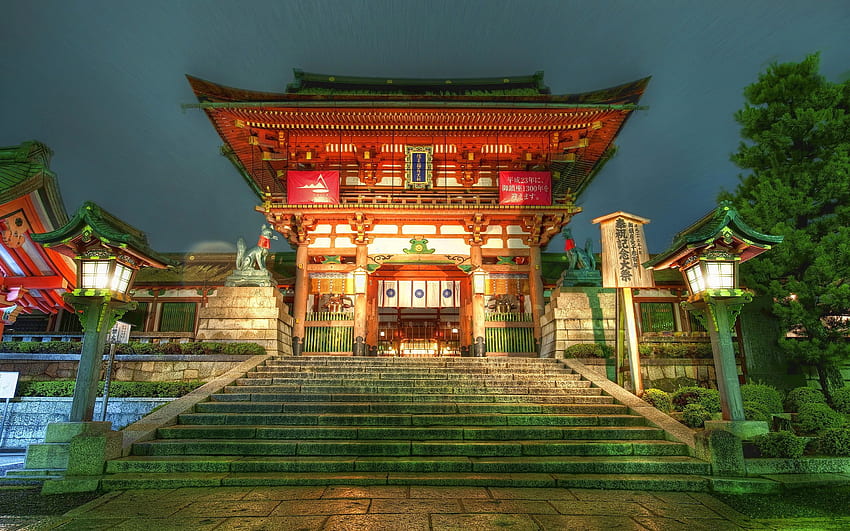
Whispers of the Ancients: Exploring the Sacred Beauty of Shinto Shrines

Shinto shrines, with their serene beauty and deep spiritual significance, invite us to engage with the ancient traditions of Japan. These sacred spaces are more than mere structures; they are a harmonious blend of nature, architecture, and spirituality, where the land itself is believed to host the divine. Each shrine tells a story, echoing the whispers of generations past and offering a glimpse into the unique relationship between the Japanese people and their deities.
Walking through the torii gates that mark the entrance to a shrine, visitors are transported to a realm of tranquility and reflection. The simplicity of the designs, often surrounded by lush greenery, creates an atmosphere that encourages contemplation and a profound sense of peace. As we explore these enchanting sites, we uncover not only the artistry and craftsmanship involved but also the rich history and vibrant rituals that continue to thrive in contemporary Japan.
Famous Shinto Shrines
History of Shinto Shrines
Shinto shrines trace their roots back to ancient Japan, where nature and the elements were revered as sacred entities. The indigenous belief system of Japan, known as Shinto, did not initially have organized religious structures, but over time, specific sites, such as sacred trees, mountains, and springs, became focal points for worship. These places were considered home to kami, or spirits, which are central to Shinto belief. As communities began to identify and honor these kami, the concept of dedicated spaces for worship emerged, leading to the establishment of the earliest shrines.
The development of Shinto shrines was significantly influenced by the introduction of Buddhism to Japan in the 6th century. This interaction led to the blending of the two belief systems, resulting in the elaboration of shrine architecture and practices. Many shrines adopted architectural elements from Buddhist temples, such as decorative features and layout orientations. Furthermore, the imperial court played a crucial role in the proliferation of Shinto shrines, as emperors would sponsor the construction of shrines to legitimize their authority and reinforce the divine connection between the ruler and the kami.
By the Edo period, Shinto shrines had become integral to Japanese culture and society. The introduction of state-sponsored Shinto during the Meiji Restoration further solidified their importance, as they were promoted as symbols of national identity. This era saw the formalization of shrine organization and the codification of rituals and festivals, allowing Shinto shrines to thrive and evolve. Today, these sacred spaces serve not only as sites for spiritual reflection and community gathering but also as artifacts of Japan’s rich cultural heritage, inviting visitors to connect with the profound history and beliefs of the ancients.
Architectural Elements
The architectural design of Shinto shrines is deeply rooted in the natural environment, reflecting the Shinto belief in the sacredness of nature. Many shrines are constructed using natural materials such as wood and thatch, harmonizing with their surroundings. This organic approach not only emphasizes sustainability but also embodies the spiritual connection that Shinto practitioners have with the elements around them. The simplicity and elegance of these structures often evoke a sense of peace and tranquility, inviting visitors to pause and reflect.
One of the most recognizable features of Shinto shrines is the torii gate, which marks the transition from the mundane to the sacred. Typically painted in bright vermilion, torii gates signal the entrance to a shrine and symbolize purification and the beginning of a spiritual journey. They serve not only as physical barriers but also as spiritual markers, guiding worshippers into a realm where they can connect with the kami, or spirits. Each torii gate carries its unique story and significance, adding to the cultural richness of the shrine complex.
Additionally, the layout of Shinto shrines often includes a path that meanders through lush gardens, leading to the main hall or honden. This carefully planned approach promotes a sense of meditation and mindfulness as visitors engage with the environment. The honden itself, generally featuring a steep, gabled roof and minimal ornamentation, is a focal point of worship where rituals and offerings take place. This design philosophy highlights the reverence for simplicity and the belief that beauty emerges from unadorned purity, creating a profound sense of sacred beauty throughout the shrine grounds.
Cultural Significance
Shinto shrines hold profound cultural significance in Japan, acting as focal points for community life and spiritual practice. They serve not only as places of worship but also as centers for festivals, rituals, and gatherings that strengthen community bonds. Through the centuries, these shrines have become venues for various celebrations that highlight local traditions, thus preserving and reinforcing the cultural identity of the regions in which they are located.
The architectural design of Shinto shrines reflects deep-rooted aesthetics and spiritual beliefs. Each shrine is carefully constructed to harmonize with its natural surroundings, embodying the Shinto principle of living in accordance with nature. The use of specific materials and design elements, such as the torii gate, symbolizes the transition from the mundane to the sacred. This relationship between the shrine’s physical structure and its environment reinforces the cultural value placed on nature in Japanese society.
Additionally, Shinto shrines are repositories of history and heritage, often housing centuries-old artifacts and artworks. Many shrines are associated with specific deities, historical events, or significant figures, making them integral to Japan’s narrative. They provide a sense of continuity and connection to the past, inviting visitors to reflect on their history while engaging with living traditions that are celebrated through rituals and pilgrimages.
Visiting Shrines Today
Visiting Shinto shrines offers an opportunity to connect with Japan’s spiritual heritage while experiencing its unique architectural beauty. Each shrine, adorned with intricate woodwork and traditional thatched roofs, serves as a testament to centuries of devotion and artistry. The tranquil surroundings often include serene gardens and natural landscapes, inviting visitors to pause and reflect amidst the hustle of modern life.
Many shrines are not just relics of the past; they remain active places of worship where rituals and festivals continue to thrive. Visitors can witness traditional ceremonies, such as Shinto weddings or seasonal festivals, which provide a glimpse into the living cultural practices of the Japanese people. Engaging with shrine staff and fellow visitors can enhance this experience, as stories and understandings of the rituals are shared.
For those seeking a deeper connection, participating in purification rituals, making offerings, or drawing omikuji (fortune slips) allows for personal reflection and insight. Each shrine has its own unique charm and significance, making every visit a different experience. Whether drawn by spiritual curiosity or a love for nature and history, visitors leave with a profound appreciation for the sacred beauty of Shinto shrines and their role in Japanese culture.



